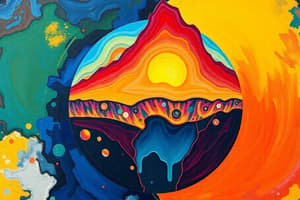Podcast
Questions and Answers
What are the three main layers of the Earth?
What are the three main layers of the Earth?
- The lithosphere, the asthenosphere, and the mesosphere
- The upper mantle, the lower mantle, and the core
- The surface, the middle, and the core
- The crust, the mantle, and the core (correct)
What is the Earth's crust composed of?
What is the Earth's crust composed of?
- Basalt, gabbro, and granite (correct)
- Sand and clay
- Limestone and marble
- Iron and nickel
What allows the tectonic plates to move?
What allows the tectonic plates to move?
- The asthenosphere (correct)
- The upper mantle
- The lower mantle
- The lithospheric mantle
What is the thickest layer of the Earth?
What is the thickest layer of the Earth?
What is the primary composition of the Earth's core?
What is the primary composition of the Earth's core?
How are the Earth's first oceans believed to have formed?
How are the Earth's first oceans believed to have formed?
What causes the formation of volcanoes?
What causes the formation of volcanoes?
What geological process leads to earthquakes?
What geological process leads to earthquakes?
What is responsible for shaping the Earth's surface over billions of years?
What is responsible for shaping the Earth's surface over billions of years?
What is the Earth primarily believed to have formed from?
What is the Earth primarily believed to have formed from?
Flashcards are hidden until you start studying
Study Notes
Earth: Our Home Planet
Earth, the third planet from the sun, is a remarkable place that has been the cradle of life for millions of years. It is unique in the solar system and has been shaped by geological processes over billions of years. Let's explore the fascinating world of Earth, focusing on its geology.
Earth's Structure
The Earth is divided into three main layers: the crust, the mantle, and the core. The crust is the outermost layer, providing a solid surface for life to evolve. The mantle is the thickest layer, making up about 84% of the Earth's volume. The core is the innermost part of the Earth, divided into a solid inner core and a liquid outer core.
Crust
The Earth's crust is the outermost layer, ranging from 50 km thick under the oceans to about 70 km thick under the continents. It is composed of several different types of rocks, including basalt, gabbro, and granite. The crust is also broken into several large pieces called plates that constantly shift and move, causing earthquakes and volcanic activity.
Mantle
The Earth's mantle is a thick layer of silicate rocks and minerals, making up about 84% of the Earth's volume. It is divided into two parts: the upper mantle and the lower mantle. The upper mantle is semi-solid and is broken up into two large regions: the lithospheric mantle, which is rigid and supports the tectonic plates, and the asthenosphere, which is semi-fluid and allows the tectonic plates to move.
Core
The Earth's core is divided into a solid inner core and a liquid outer core. The core is composed primarily of iron and nickel, with some smaller amounts of other elements. The inner core is believed to be about 1,220°C (2,230°F) and is under so much pressure that it is believed to be in a solid state. The outer core is in a semi-fluid state and is responsible for generating the Earth's magnetic field.
Earth's Formation
The Earth formed about 4.5 billion years ago from a giant cloud of gas and dust called the solar nebula. Over time, the planet's surface was shaped by volcanic activity, plate tectonics, and the movement of water. The Earth's first oceans were formed when water from comets and asteroids combined with water vapor and steam released by early volcanic activity.
Earth's Geology
Earth's geology is shaped by the movement of the tectonic plates, which are pieces of the Earth's crust. These plates can move in different ways, causing various geological phenomena.
Volcanic Activity
Volcanoes are formed when magma, or molten rock, rises to the Earth's surface. This can happen when tectonic plates move apart, allowing magma to rise and form a new volcano. Volcanic activity can also occur when plates collide, causing magma to be pushed up and out of the Earth's surface.
Earthquakes
Earthquakes occur when tectonic plates shift along their edges, releasing energy in the form of seismic waves. These waves can cause the ground to shake, causing earthquakes. Earthquakes can range in size from very small, barely noticeable events to massive quakes that can cause widespread damage.
Plate Tectonics
Plate tectonics is the movement of the Earth's crust, which is divided into several large pieces called tectonic plates. These plates move slowly over time, sometimes colliding with each other, causing geological activity. This movement has shaped the Earth's surface over billions of years, creating mountains, valleys, and other geological features.
Conclusion
The Earth is a fascinating planet, shaped by geological processes that have occurred over billions of years. From its structure to its formation and geology, the Earth is a unique and complex world that has been the cradle of life for millions of years. By understanding the geological processes that have shaped our planet, we can gain a deeper appreciation for the world we call home.
Studying That Suits You
Use AI to generate personalized quizzes and flashcards to suit your learning preferences.




